Abstract
The current study aims to conduct a comprehensive analysis of the key parameters that affect the energy output of the Bagisli Hydropower Plant, located on the Zap River in the Dicle (Tigris) basin of Turkey. It considers the daily data for the time interval of 2016–2019 related to flow rate, precipitation, and temperature in relation to the generation of electricity. The relationship between energy output and flow rate is evident; however, the energy production is limited by the design flow rate. The largest flow rates were seen during the spring season after the occurrence of peak precipitation, which exhibited a shifting pattern. Similarly, energy generation also reaches its highest level during this time period. Another outcome of this study is that there is no apparent association between daily precipitation and daily energy generation. Moreover, a novel correlation with an R2 value of 0.89 has been proposed, in the deviation band of ±20%, to estimate energy generation when only flow rate data are available.
1. Introduction
The expansion of both the population and industrial sectors has led to a significant surge in worldwide energy consumption. Hydropower stands out as the predominant renewable energy source, constituting a significant proportion of the entire renewable energy portfolio, with a commanding share of 83.6% [1]. The growing interest in hydropower development may be attributed to many factors, including reduced emissions of carbon dioxide and other gases, increased efficiency, enhanced operational flexibility, lower operating and maintenance costs, and potential economic benefits [1,2]. The generation of electricity from hydropower facilities is subject to the effect of several characteristics and circumstances, including the particular design and geographical placement of the plant. Water flow rate or discharge is one of the main effective parameters that directly affects energy generation. The “head” is another key factor that directly influences the magnitude of gravitational potential energy, determining the amount that can be harnessed and transformed into electrical energy. Turbine and generator efficiencies, reservoir size, seasonal and weather variations, ecological flow requirements, maintenance, sedimentation, etc., are also effective parameters in energy generation from a hydropower plant. The optimization of these parameters has significant importance in the context of optimizing the energy output and efficiency of hydropower facilities, while simultaneously limiting their environmental effect [3]. Furthermore, the selection of hydropower technology, such as run-of-river or reservoir types, has a substantial impact on energy generation and the adaptability of the system.
Energy generation from hydropower plants is significantly influenced by seasonal variations, with the impact depending on the geographical placement and structural characteristics of the hydropower installation, potentially having a substantial effect on water resources [4,5] including the hydrological regime of the basin [6,7,8,9]. Seasonal fluctuations may directly impact hydropower output via many processes, including alterations in precipitation, river flow changes, evaporation changes, sedimentation, and dam safety [10,11]. For instance, energy generation from hydropower plants can be affected by variations in the pattern of precipitation [12,13,14]. Besides the precipitation pattern, availability of water sources, hydrological cycle, air temperature, and river discharge (flow) also have significant impacts on energy generation [15,16]. The rise in the strength and occurrence of severe weather phenomena might potentially have negative consequences on hydropower systems and heighten the hazards linked to crucial circumstances for energy generation [17].
The cost-effectiveness, lower emissions, and rapid response to peak demands make hydroelectricity a beneficial energy generation method. Consequently, much emphasis is being placed on the examination of the consequences of the aforementioned parameters on hydropower plants. Numerous investigations have analyzed the effects of climatic fluctuations on various regions [18,19,20,21,22], specifically focusing on increased temperatures, higher evaporation rates, changes in annual precipitation patterns, changes in mean flows, and alterations in river regimes resulting in reduced runoff [23,24,25]. A recent study on the examination of the impact of seasonal variations on the capacity for the generation of power from photovoltaic solar and hydropower plants in Brazil has been conducted by Medeiros et al. [26]. The analysis of trends indicates that there was a yearly rise of 3.43 mm in total rainfall at the plant site during the studied period. However, there was a corresponding drop in electricity output of 3.23 MWh per year due to the prioritization of water use for human consumption and irrigation reasons. It is concluded that the incorporation of climatic patterns into energy system planning is crucial, since the unpredictability of the climate may cause significant swings in the generation of renewable power. Ceribasi et al. [27] performed an investigation on the effects of variations in several climatic parameters including the precipitation, temperature, and humidity on the power generation from hydropower plants located in Turkey named Dogancay I and II. According to their study, which uses a new trend analysis method, it is revealed that precipitation, temperature, and humidity have significant effects on energy generation. Yu et al. [28] present a methodology for examining the effects of climate alterations on reservoir inflows and the hydropower plants in the Dajia River located in Taiwan. It was found that the potential increase in temperature, which results in an elevated demand for electricity in the summer season, could potentially affect the stability of the electricity supply due to the reduction in the generation of hydropower. As generally known, changes in precipitation have a crucial role in determining the magnitude of variations in flow rate and hydropower output; Wagner et al. [29] reveal the degree of possible effects of precipitation on hydropower generation. A study conducted by Mohor et al. [30] aimed to assess the effects of climate forecasts on the hydrological regime of the Tapajós Basin in the Amazon. An analysis was conducted to examine the effects of these alterations on the anticipated operation of a hydropower plant. The majority of predictions indicated a decline in basin discharge as a consequence of precipitation variations. In the forecasted scenarios, there was evidence to suggest that the yearly hydrological cycle is seeing an increase in the length of low discharges. The findings presented in the study are linked to an extended duration of the dry season, as predicted by the climate projections. Another projection study was performed by Markoff and Cullen [31] and revealed that the energy generation from hydropower plants decreases in nearly all projections. Besides the aforementioned studies, there are various studies on the determination of the effects on hydropower energy generation due to seasonal variabilities. For instance, while Novitasari et al. [32] examined the influence of climate change and land use on energy generation, Yulistiyanto et al. [33] studied the effect of flow discharge on energy generation.
As summarized, hydropower emerges as the prevailing renewable energy source, comprising a substantial share of the overall renewable energy portfolio. The generation of energy from hydropower plants is influenced by several factors and conditions, such as the specific design and geographical location of the plant, in addition to seasonal variations. The present study undertook a thorough examination of the important factors that influence the energy generation of a selected hydroelectric facility, known as the Bagisli Hydropower Plant, which is situated on the Zap River within the Dicle basin in Turkey, considering the daily data for the time interval of 2016–2019 related to flow rate, precipitation, and temperature in relation to the generation of electricity. Apart from relevant literature, as partly summarized before, this study comprehensively analyzes the mentioned effective parameters using long-term daily data to enhance the efficiency of hydropower facilities and guarantee a reliable and adequate energy supply throughout the year. Furthermore, to the best of the author’s knowledge, there is no equation composed of flow rate parameters to determine the energy generation in the case of the availability of only flow rate data, while the present study proposes a correlation with acceptable accuracy.
2. Materials and Methods
Characterization of Studied Area
The hydropower plant being investigated is the Bagisli Regulator and Hydropower Plant (HPP), referred to hereafter as Bagisli HPP, situated on the Zap River. It operates as a run-of-river (RoR)-type hydropower plant. The length of the river is nearly 200 km (in Turkey) and the basin area of the river and its tributaries spans around 26,325 km2, with 35% of the catchment being within the territorial boundaries of Turkey, while the other part is situated in Northern Iraq [34]. The Dicle basin, which contains the Zap River, is located in the southeast of Turkey, as shown in Figure 1, and is one of the twenty-six basins. The yearly mean flow rate of Dicle Basin is 21.3 km3 and with Firat Basin, the two basins share 28.5% of all flows in Turkey [35]. The Zap River feeds the Dicle (Tigris) River with a mean yearly flow volume of 292 m3/s.
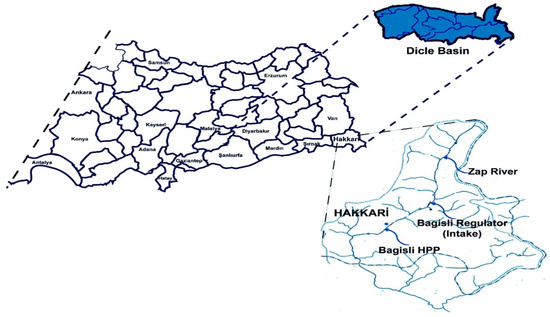
Figure 1.
Location of Dicle (Tigris) Basin, Zap River, and Bagisli HPP.
Bagisli HPP, which is located in Hakkari Province, was commissioned in 2009. The exact location of the HPP is within 37°42′49″–37°43′55″ northern latitudes and 44°03′17″–44°05′09″ east longitudes. The rain area is approximately 2889 km2. The installed capacity of the HPP is 30 MW and its estimated energy generation is 100 GWh/year [36]. The project area is mainly composed of a regulator that stores and regulates the water, transmission tunnels, penstock, and power house. Figure 2 illustrates the locations of the stream gauging station numbered 2621 and the length of the transmission tunnels. While the distance between the gauging station and the regulator is 3 km, the distance between the regulator and the power house is nearly 3.3 km. The stored water in the regulator is transferred via a transmission tunnel along the 3.3 km.
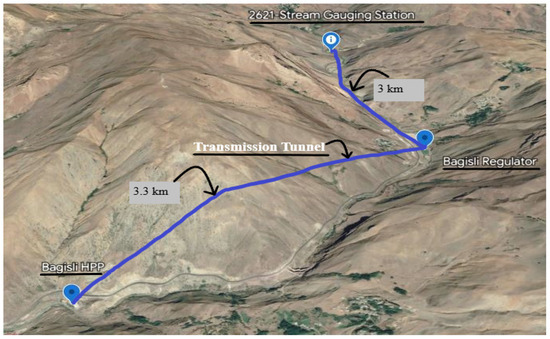
Figure 2.
Orientation of main components of power plant and stream gauging station.
The design flow and mean flow, which are given in Table 1 as 31.24 m3/s and 15.16 m3/s, respectively, are determined by the data obtained from 2621 numbered stream gauging stations. The further technical specifications are summed up in Table 1.

Table 1.
Technical specifications of Bagisli HPP.
3. Data Collection
3.1. Temperature
The air temperature data of the studied field were obtained from the Turkish State Meteorological Service [37] for 2016–2019 at the points of 37°47′15″ northern latitudes and 44°07′23″ east longitudes. The given official gauging station, which is the nearest temperature measurement station to the stream gauging station numbered 2621, is 5 km away from the stream gauging station. Data attained from the indicated official station represent the general temperature characteristics of the examined area, which consists of a stream gauging station, regulator (intake), and power house. Figure 3 demonstrates the daily temperature variation of the given field, including the values of the years between 2016 and 2019. When the temperature characteristics given in the figure are analyzed, it can be seen that the studied region has a continental climate. For the specified time interval, the highest and lowest recorded temperatures are 26.8 °C and −22 °C, respectively. In general, it can be seen that the temperatures of the area are below 0 °C for the months of December, January, and February, in the interval of −22 °C–0 °C, which have the lowest recorded temperatures throughout the year. On the other hand, at the end of June, July, and August, the observed temperatures are in the range of 16 °C–26 °C for the given years.
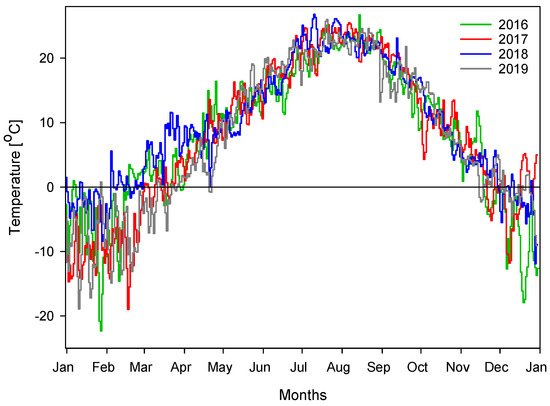
Figure 3.
Temperature characteristics of the studied field.
It can be deduced from Figure 3 that the mean air temperatures of the area in the summer season, including June, July, and August, are increasing for the successive years studied. In 2016, the mean temperature of the summer months was 20.1 °C, while this value was calculated as 21.06 °C in 2017, 21.25 °C in 2018, and 21.43 °C in 2019. Considering the years examined, partial increases were observed in the mean temperatures of the summer months. On the contrary, although there were no significant changes in the mean temperatures of the winter months consisting of December, January, and February in the years examined, while the mean temperature of the relevant months was around −6 °C, this value increased in 2018 and was calculated as −1.8 °C.
3.2. Precipitation
The precipitation data for the examined area were acquired from the Turkish State Meteorological Service for the period of 2016 to 2019 [22]. The data were collected at certain geographical coordinates, namely 37°47′15″ northern latitudes and 44°07′23″ east longitudes. The gauging station, which is the closest station to the stream gauging station, is also located at a distance of 5 km from the stream gauging station as the air temperature measurement station. The distance between the station where precipitation measurements were obtained and the HPP under examination is approximately 8 km. The data obtained from the designated official station provide an overview of the precipitation patterns in the studied region. Figure 4 represents the daily precipitation of the studied area in mm, for the time range of 2016–2019. The concentration of precipitation occurs mostly throughout the winter and spring seasons, namely from November to May, accounting for around 90% of the total annual precipitation. The yearly total precipitation ranges from 220 mm to 530 mm, while the monthly mean precipitation varies between 20 mm and 43 mm. Notably, in the period spanning from 2016 to 2019, 2016 experienced the lowest total precipitation, whereas 2018 recorded the highest total precipitation. A considerable proportion of the yearly precipitation is mostly in the form of rainfall, with the exception of the elevated areas where snowfall persists, but with lesser significance. The studied location has a high precipitation season throughout the spring period, with peak precipitation often occurring in the month of April. In the summer season, which consists of the months of June, July, and August, the precipitation goes down to its lowest values.

Figure 4.
Precipitation characteristics of studied field.
3.3. Flow Rate
Data from the stream gauging station are used to determine the flow characteristics of the Zap River, particularly in the studied field. The data pertaining to the analyzed region were obtained from the General Directorate of State Hydraulic Works [35], covering the time span from 2016 to 2019. The station, named 2621-Stream Gauging Station, is located at 37°45′34″ northern latitudes and 44°03′21″ east longitudes, and is 3 km away from Bagisli Regulator, as shown in Figure 2. The design flow and mean flow of the Bagisli HPP and river, which are 31.24 m3/s and 15.16 m3/s, respectively, were also determined with data obtained from the mentioned gauging station. The gauged water is held in the regulator and transferred through the transmission tunnel to the penstock and then to the power house. It should be noted that the given gauge station has a crucial role in the operation of the power plant and the projection of energy generation.
Figure 5 demonstrates the recorded daily flow rates via the stream gauge station located in the Zap River, for the range of 2016–2019. The mean flow rates for the given time interval showed that the minimum and maximum monthly total flow rates were 87 m3/s in September 2017 and 1972.8 m3/s in May 2019, respectively. Additionally, the monthly mean flow rate for four years is 381.2 m3/s. In terms of the annual mean flow rates, the lowest value was recorded in 2017 at 315 m3/s, while the highest value was recorded in 2019 at 510 m3/s. The long-term daily mean flow rate is obtained as 11.46 m3/s for the 60 years, while it is 12.53 m3/s for the studied time interval. The difference between the two flow rate values is not significant for the examination of the studied project field. It can be seen in Figure 6 that from October to the end of February, nearly a constant flow occurred. The flow rates peak in June and exhibit a steep upward trend starting from March. The daily average flows declined from the end of June, exhibiting a similar pattern to that seen between March and June, but in a decreasing form. It may be derived from the figure that the plots of 2018 and 2019 demonstrate a shifting trend to July according to the other years. The possible reason behind this shift may be the changing precipitation characteristics of the studied field.
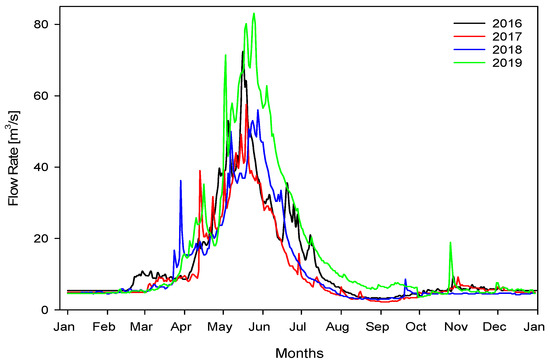
Figure 5.
Flow rate characteristics of the Zap River.
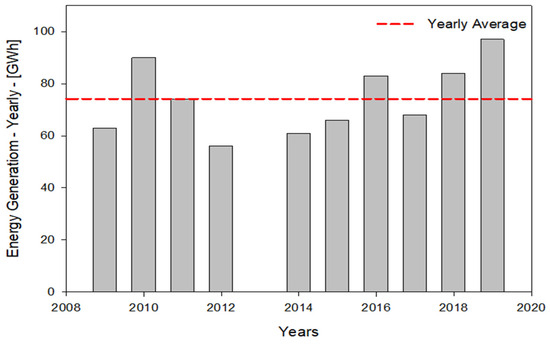
Figure 6.
Yearly energy generation of Bagisli HPP.
3.4. Energy Generation
The energy generation characteristics of Bagisli HPP are determined using the hourly energy generation data obtained from Energy Exchange Istanbul (EXIST), which is an energy exchange company founded in 2015 and licensed by the Energy Markets Regulatory Authority (EMRA) of Turkey [38]. Bagisli HPP has been generating energy since 2009, and the energy generation values for the operated years, within the unavailability of the values of 2013, are given in Figure 6. The maximum yearly energy generation occurred in 2019 with 98 GWh, while the minimum was in 2012 with 56 GWh. The difference between maximum and minimum energy generation is 42 GWh, which is 75% higher than the minimum energy generation value. The mean annual energy output for all years of generation was 74 GWh. The amount is around 25% less than the estimated total annual energy generation capacity of 100 GWh, as mentioned in the project file. Upon analyzing the data from 2016 to 2019, it was determined that the mean annual energy output equaled nearly 84 GWh. The amount of energy generated closest to the expected energy generation value stated in the project file was achieved in 2019 and recorded as 98 GWh. The figure shows that energy generation from Bagisli HPP exhibited a fluctuating characteristic. The possible reasons behind these fluctuations may be the freezing of the stored water in the regulator due to the low level, insufficient rains, maintenance, and the duration of summer seasons.
Figure 7 illustrates the daily energy generation of the hydropower plant for the time interval of 2016–2019, and it can be seen that energy generation in 2019 surpasses that of the other years. The daily total energy generation was derived by summing the hourly energy generation data acquired from Energy Exchange Istanbul (EXIST) [38]. The peak energy generation of HPP occurred from the end of May to the end of June due to the rains and melting snow, especially at the top of the mountains. The peak daily energy output reached an average of 700 MWh, consistently seen in the months of May and June over the whole study period. Energy generation rose in March and decreased at the end of June. In the winter season, especially between January and February, there were interruptions caused by the freezing of stored water in the regulator due to the low level. Similar interruptions arose between the end of August and October as a result of the inadequate flow rate.
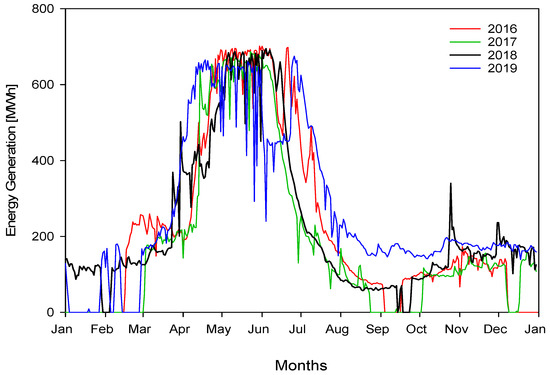
Figure 7.
Daily energy generation of Bagisli HPP for the given years.
4. Results and Discussion
The energy generation of a hydropower plant may be impacted by several factors, which might vary depending on the specific design and geographical location of the facility. Hydropower energy generation is mostly affected by seasonal variations, which are principally driven by alterations in precipitation patterns, temperature fluctuations, and water availability. Comprehending and effectively controlling the fluctuations in seasons are vital in order to maximize the efficiency of hydropower facilities and guarantee an adequate and uniform supply of electricity over the whole of the year. Within the context mentioned, effective parameters for the energy generation of a selected hydropower plant, named Bagisli HPP, have been comprehensively investigated based on the daily data related to flow rate, precipitation, and temperature compared to energy generation.
Figure 8a–d illustrate the variation in monthly total precipitation, flow rate, and energy generation data, whose sources have been mentioned before, with respect to each other for the given time interval of 2016–2019. It is clearly seen from the figure that flow rate and energy generation have a direct relationship in all sub-figures. When the flow rate reaches its peak level, energy generation also reaches its highest value; thus, the two indicators act in a similar way. Throughout the analysis, the mean daily energy output in May attained the peak value of 640 MWh. Similarly, while analyzing the daily mean flow, it was found that the maximum value of the daily mean flow recorded in May was 47 m3/s. When analyzing the energy generation data and flow rates in unit days, the energy generated in 2016 was 230 MWh/day with a daily mean flow rate of 12.8 m3/s. In 2017, the values were 190 MWh/day and 10.5 m3/s, in 2018 they were 226 MWh/day and 11.4 m3/s, and in 2019 they were 272 MWh/day and 17.1 m3/s. The findings clearly demonstrate that variations in mean daily flow values directly impact energy generation values. However, in some months of the given years, although there was flow in the river, no energy was generated, especially in extremely cold months. This outcome may arise from the freezing of the water in the regulator due to its low level.
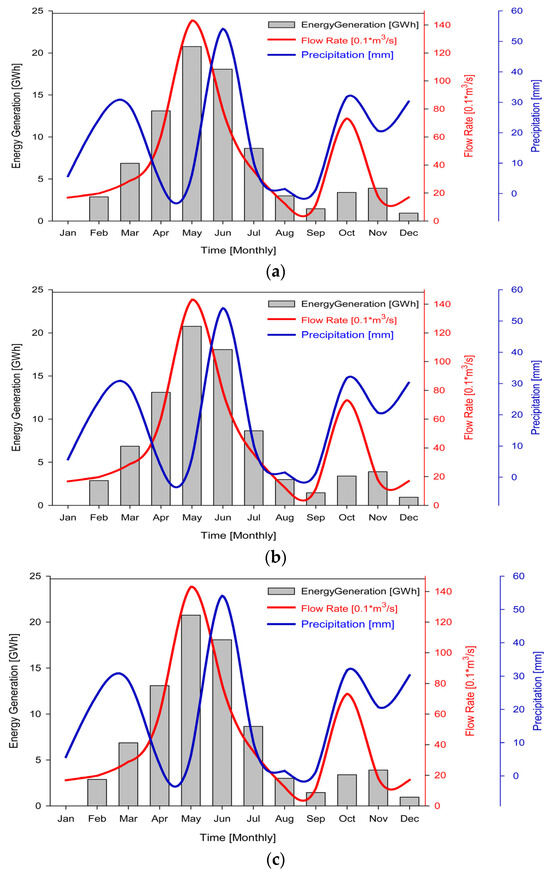
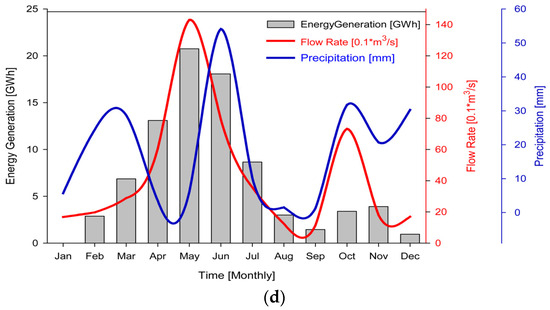
Figure 8.
Variation in monthly energy generation, flow rate, and precipitation for the given years, (a) 2016, (b) 2017, (c) 2018, and (d) 2019.
Generally, it is known that the link between precipitation and river flow rate (discharge) is of utmost importance in the context of hydropower generation since it directly impacts the accessibility of water that augments the total resources for the purpose of power generation. Figure 8a–d show the variation in monthly flow rate that occurred in the stream gauging station on Zap River, which passes through the Bagisli HPP, with respect to monthly precipitation data. It can be deduced from the figure that a relationship between precipitation and flow rate occurs in the spring season consisting of the months of March, April, May, and June, especially in Figure 8b–d. In the given figures, firstly, the precipitation rate increases and has a peak level, and then the flow rate increases and has a peak, due to the shifting data of precipitation for the mentioned months. When the total monthly precipitation changes by year are analyzed, it can be seen that the peak values in precipitation are obtained in the spring months. However, in Figure 8d, the monthly mean precipitation value in January differs from other years. Prior to the peak value observed between March and April, high precipitation was also observed in January, but it returned to seasonal averages in February. Due to the continental climate of the region, precipitation between December and February is generally in the form of snow. In the relevant months, daily air temperature averages vary between −2 °C and −8 °C. The instantaneous effect of precipitation in the form of snow on the flow rate may be more limited compared to rainfall. The daily mean precipitation, defined as the amount of precipitation each day, ranges from 0.6 mm/day to 1.5 mm/day. The daily mean unit flow rate ranges from 10.5 m3/s to 17.1 m3/s. When examining the mean daily precipitation values during the spring season (March to May), the data show that it was 1.5 mm in 2016, 2.0 mm in 2017, 2.5 mm in 2018, and it was also 2.5 mm in 2019. Additionally, the mean daily flow rates for the same time periods were recorded as 31.4 m3/s, 26.1 m3/s, 32.5 m3/s, and 41 m3/s, respectively. Upon analysis of the data, it is evident that the unit flow rate has a positive correlation with mean daily precipitation, with the exception of the year 2016. When the unit daily energy generation values for the same monthly periods are compared, it can be seen that 28.9 MWh units of daily energy generation were obtained in 2016, 23.3 MWh in 2017, 30 MWh in 2018, and 38 MWh in 2019. The effect of the change in the actual unit daily flow and precipitation values is seen in the unit daily energy generation, except for 2016.
Figure 8a–d show the characteristics of monthly total energy generation, flow, and precipitation values for the years analyzed. Monthly total flow and energy generation values have formed a distinct profile with little variation over the years. In this profile, flow rate and energy generation values increase in spring, while they show a decreasing trend in the rest of the year. On the other hand, although the profile formed by the monthly total precipitation amounts varies according to the years, it generally forms peaks in the spring and autumn months. It can be seen that the peaks in the spring months contribute to energy generation, while the peaks in the autumn months do not contribute significantly to energy generation. For example, in Figure 8a–c, while precipitation increases in the summer and autumn, the flow rate stays constant. This may result from the high evaporation rate in the summer and autumn seasons, which are the driest times of the year. Also, energy generation from the hydropower plant for the given time period shows an unchanging trend. Additionally, Figure 8a acts differently from other related figures. The peak of precipitation occurred before the flow rate peak, but it had a lower-level peak before the flow rate peak. The lower peak of precipitation may have supplied enough water for the river flow rate.
In essence, the correlation between precipitation and river flow rate has significant importance in the functioning of hydropower facilities. Comprehending and effectively overseeing this association is important in order to maximize energy generation and guarantee the long-term viability of hydropower energy.
4.1. Energy Generation vs. Temperature
The hydrological cycle is subject to the effect of air temperature, which has a direct impact on the overall water availability within rivers and reservoirs. High or extremely cold temperatures have the potential to induce alterations in precipitation patterns, increase evaporation rates, especially at high temperatures, and alter the timing of snow melting. The alterations have the ability to influence the magnitude and distribution of water discharge, which has a direct impact on the capacity of hydropower facilities to generate energy. Figure 9a–d show the variation in energy generation compared to air temperature for the mentioned years, using daily data. From the outcomes of the comparison of energy generation and temperature data, the adverse effects of air temperature on energy generation can be classified into two categories: effects at high temperatures and effects at extremely low temperatures. The air temperature of the studied area varies between −22 °C and 26.8 °C. The boundaries of the given temperature interval consist of the highest value in 2018 and the lowest value in 2016. It can be seen from the figure that in the winter season, the cold temperatures were recorded in the range of −10 °C and −20 °C, except for the year 2018. Figure 8a–d display the monthly total energy generation, and it is evident that energy generation throughout the winter months, particularly in January and February, was at its lowest levels, comparable to August and September. A circumstance that is quite similar to the one that is shown in Figure 8a–d, which depict monthly energy generations, can be seen in Figure 9a–d, which depict daily energy generations and air temperatures with respect to each other. Figure 9a–d demonstrate that there is no energy generation in the extremely cold (<−20 °C) temperature range. Furthermore, the daily energy output reaches its lowest level when the temperature falls between 0 °C and −20 °C. The cause of this outcome is the solidification of the water contained in the regulator and river bed as a consequence of the reduced water level. Moreover, based on the mean temperatures recorded in December, January, and February, the lowest mean temperature was −6.9 °C in 2017, while the highest mean temperature for these months occurred in 2018 at −1.8 °C. The lowest energy output recorded for December, January, and February of the relevant years was 862 MWh in 2017, while the maximum energy generation was 3796 MWh in 2018. It is observed that higher mean winter temperatures lead to increased energy output during those months.
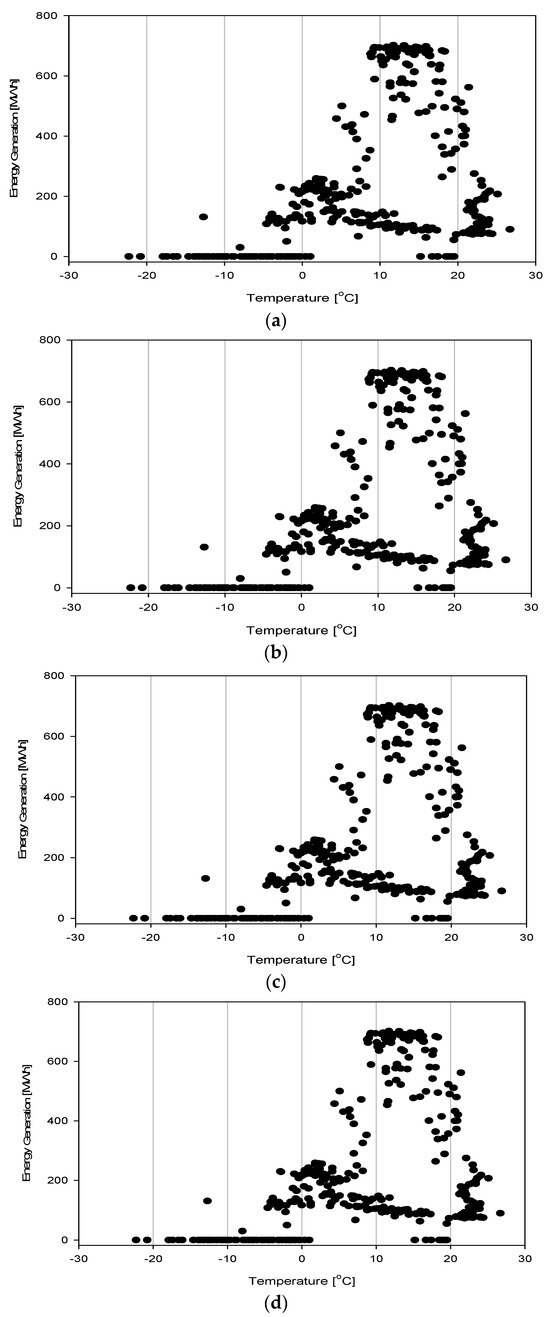
Figure 9.
Alteration in daily energy generation with respect to temperature, (a) 2016, (b) 2017, (c) 2018, and (d) 2019.
The energy generation rate increases with the increase in recorded temperature until its value reaches values around 20 °C, and it can be seen that the maximum energy generation occurs in the temperature interval of 5 °C–20 °C, and the mentioned recorded warmer air temperatures also belong to the time period of the spring season. Beyond 20 °C, energy generation decreases due to two possible reasons: an increase in temperature that results in high evaporation and a decrease in precipitation during the summer season.
The provided figures demonstrate a correlation between the energy output of the HPP and air temperature, indicating that the energy generation of HPPs is directly influenced by air temperature. Moreover, it is crucial to recognize that the influence of air temperature on hydroelectric energy generation may vary depending on variables such as geographical location, type of hydropower system, and local hydrological conditions.
4.2. Energy Generation vs. Precipitation
It is known that the energy generation of hydropower plants is heavily dependent on precipitation, given that these facilities operate by harnessing the flow of water. Therefore, the deviations in patterns of precipitation have the potential to induce fluctuations in river flow. Extensive periods of insufficient precipitation have the potential to diminish river flow, thereby exerting an influence on the energy generation capacity of hydropower facilities. On the contrary, substantial precipitation has the potential to enhance river flow, thereby optimizing the generation of hydropower. Figure 10a–d illustrate the variation in daily energy generation of Bagisli HPP in contrast with daily precipitation in the studied field for the given time interval. It should be noted that the given figures have been produced using the daily precipitation data and daily energy generations, which are the sources of the data mentioned before. It can be concluded from the figures that the daily precipitation has no impact on daily energy generation, which means there is no correlation between them. As can be seen in Figure 10a–d, energy generation can be achieved at a high level even on days when precipitation is 0 mm. The reason for this situation is that when the monthly total precipitation characteristics are examined, it takes time for the precipitation to be transmitted to the power plant as flow rate. As can be seen in Figure 8a–d, the effects of snowfall in winter and rainfall in spring are observed in the following days and months. In addition, when Figure 10a–d are analyzed, it can be seen that on some days there is no energy generation even though there is precipitation. This outcome does not state that precipitation has no impact on energy generation. Because, as given in Figure 8a,b evaluated before, which represent the variation in energy generation, flow rate, and precipitation using monthly mean data, the peak of flow rate occurs with the peak of energy generation after the peak of precipitation, which means monthly flow rate and energy generation follow the precipitation that occurred in the studied region. The highest energy generation among the studied years was attained in 2019, which had the highest precipitation value. This result clearly shows that precipitation has a direct effect on energy generation through river flow. Therefore, the unpredictability of precipitation and the possibility of alterations as a result of seasonal variations may incorporate unpredictability into the energy generation of hydropower plants over the long term.
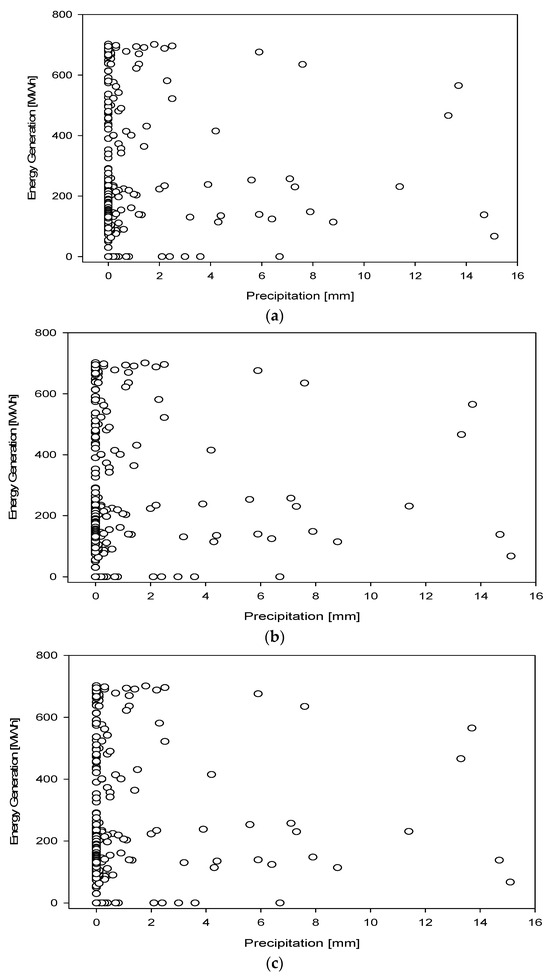
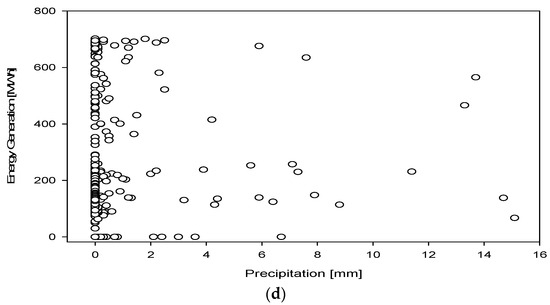
Figure 10.
Alteration in daily energy generation with respect to precipitation, (a) 2016, (b) 2017, (c) 2018, and (d) 2019.
4.3. Energy Generation vs. Flow Rate
The functionality of a hydropower facility is influenced by the hydrological circumstances of the area, which include variations in flow rates over the course of the seasons. Thus, the water flow rate occurring in a hydropower plant is a crucial determinant that has a direct impact on its energy generation. Greater flow rates correspond to a larger quantity of water being accessible for the purpose of propelling the turbines, leading to an augmentation in the generation of power while ensuring the stability and reliability of energy generation. Increases or decreases in precipitation may result in significant variations in the amount of water flow rate and availability for hydropower energy generation.
Figure 11a–d show the relationship between the daily energy generation at the power plant and the daily flow rate of the river on which the power plant is located. As can be seen in the figure, there is a linear relationship between daily flow rate and daily energy generation, unlike the relationship between daily rainfall and daily energy generation. This linear relationship continues until the power plant’s design flow level is reached. As mentioned in the Section “Characterization of Studied Area”, the design flow of the studied hydropower plant was determined to be 31.24 m3/s, given in Table 1, which means the maximum energy generation can be produced using this value. The flows that arose in the river over the design value were directed to the spillways. In the given Figure 11a–d, at some points, while the flow rate passes the design flow value, the generated energy does not reach its highest value. The reason behind this outcome is the maintenance of the whole system, including turbines. It can also be concluded that, in the presence of low flow rates, energy generation is also interrupted. In addition, the relationship between the monthly total energy generation at the power plant and the monthly total flow rate is given in detail in the section where Figure 8a–d are interpreted.

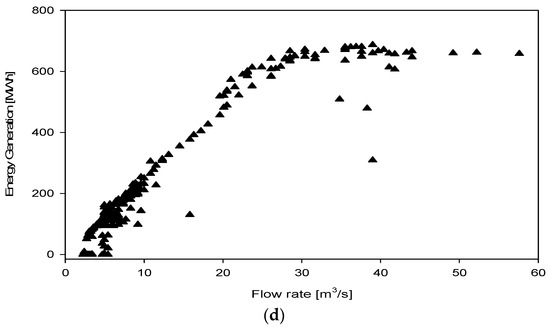
Figure 11.
Alteration in daily energy generation with respect to flow rate, (a) 2016, (b) 2017, (c) 2018, and (d) 2019.
4.4. Correlation Development
The generation capacity of a hydropower plant is contingent upon four key factors: flow rate, overall efficiency, ground acceleration, and net head, which pertains to the vertical distance that the water falls. The equation of the energy generation of the hydropower plant is given below [39,40].
where the given parameters are P, , , , and , which represent the produced power [kW], general efficiency, density of water [kg/m3], ground acceleration [m/s2], flow rate [m3/s], and net head [m], respectively. The values of the mentioned parameters in the given equation are nearly constant except for flow rate, which changes instantaneously. According to Linder et al. [41], there is a clear relationship between hydropower energy generation and stream flow (flow rate) that can be accurately represented using a statistical model. From this point of view, a novel linear correlation with an R2 value of 0.89 has been produced, given in Equation (2), using the long-term daily flow rate data and daily energy generation of the investigated hydropower plant. The only variable parameter is flow rate for the proposed equation, derived by implementing more than 1000 data points, covering 2016–2018, as shown in Figure 12.
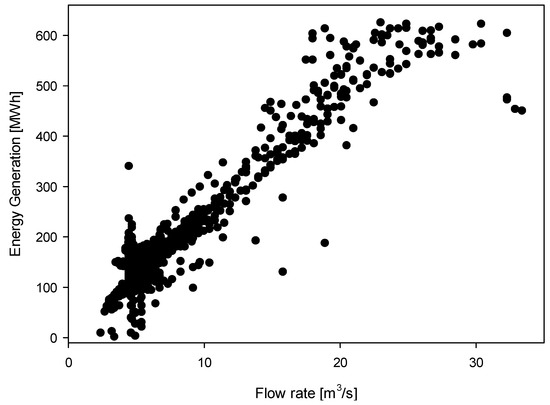
Figure 12.
Alteration in daily energy generation with respect to flow rate, limited by design flow rate.
It should be noted that the flow rates that exceeded the value of the design flow rate of 31.24 m3/s have not been taken into account in the derivation of the correlation because the given design value determines the upper limit of energy generation.
where P and Q are the energy generation [kW] and flow rate [m3/s], respectively. In Figure 13, the obtained energy generation values using the proposed correlation have been compared with the actual energy generation values of the same power plant for 2019, and it can be seen that the deviation band of the equation is in the range of ±20%. The proposed correlation, derived using more than 1000 data points of daily flow rates and energy generation, can be implemented in cases where there are only data on flow rates to obtain an estimation of energy generation.
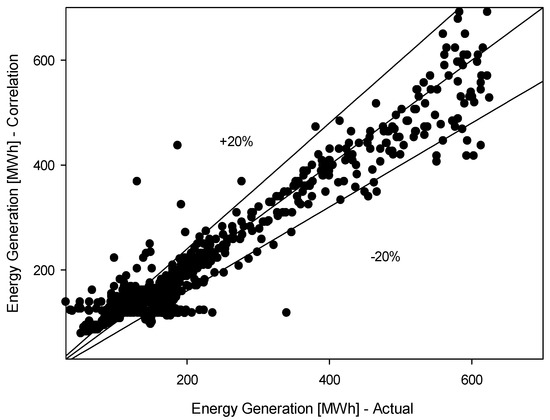
Figure 13.
Comparison of actual data with those of derived correlation.
5. Conclusions
The energy generation of hydropower plants may be influenced by several variables, which can differ according to the particular design and geographical placement of the plant, including fluctuations that occur during the seasons. The understanding and efficient management of seasonal variations are crucial for optimizing the performance of hydropower plants and ensuring a consistent and sufficient energy supply throughout the year. This study thoroughly examined the key factors influencing the energy generation of a selected hydroelectric plant, taking into account the daily data pertaining to flow rate, precipitation, and temperature in relation to energy generation. Furthermore, a novel correlation has been proposed for the estimation of energy generation in the case of the availability of only flow rate data.
Based on the comprehensive investigation that was carried out in the current study, the following deductions can be made:
- (a)
- There exists an apparent relationship between flow rate and energy generation. However, in the presence of high flow rates that exceed the design flow rate of 31.24 m3/s, the energy generation of hydropower plants reaches its highest limit.
- (b)
- The peak value of flow rate occurs during the spring season, composed of March–June, after the existence of the peak value of precipitation, which has a shifting pattern, and then energy generation likewise attains its maximum value during the same time interval. However, in the rest of the months, these exhibit distinct behaviors.
- (c)
- The effect of air temperature variation on energy generation can be divided into three sections: the effect of cold–low temperatures, warmer temperatures, and high temperatures. While cold–low and high temperatures have adverse effects on energy generation in terms of freezing and evaporation of water stored in the regulator or flowing in the river, respectively, warm temperatures support an increase in the snowmelt rate occurring in the mountains, which results in an augmentation in the flow rate of the river.
- (d)
- There is no discernible correlation between daily precipitation and daily energy output. This finding does not imply the absence of a relationship between precipitation and energy output; as it was mentioned previously, monthly mean data trends of energy generation and precipitation have a strict relationship. The year with the greatest energy generation, as shown in this study, was 2019, coinciding with the year in which the highest precipitation levels were recorded.
- (e)
- A novel linear correlation with an R2 value of 0.89 has been obtained between the long-term daily flow rate data and the daily energy output of the hydropower plant under investigation. The energy generation values generated via the implementation of the suggested correlation were compared to the actual energy generation values, and we observed that the equation’s deviation band falls within the range of ±20%.
Funding
This research received no external funding.
Institutional Review Board Statement
Not applicable.
Informed Consent Statement
Not applicable.
Data Availability Statement
The data presented in this study are available on request from the corresponding author.
Conflicts of Interest
The author declares no conflicts of interest.
References
- Balkhair, K.S.; Rahman, K.U. Sustainable and economical small-scale and low-head hydropower generation: A promising alternative potential solution for energy generation at local and regional scale. Appl. Energy 2017, 188, 378–391. [Google Scholar] [CrossRef]
- Karakoyun, Y.; Dönmez, A.H.; Yumurtacı, Z. Comparison of environmental flow assessment methods with a case study on a runoff river–type hydropower plant using hydrological methods. Environ. Monit. Assess. 2018, 190, 1–15. [Google Scholar] [CrossRef] [PubMed]
- Fung, C.F.; Lopez, A.; New, M. (Eds.) Modelling the Impact of Climate Change on Water Resources; John Wiley & Sons: Hoboken, NJ, USA, 2011. [Google Scholar]
- Giannakopoulos, C.; Le Sager, P.; Bindi, M.; Moriondo, M.; Kostopoulou, E.; Goodess, C.M. Climatic changes and associated impacts in the Mediterranean resulting from a 2 C global warming. Glob. Planet. Chang. 2009, 68, 209–224. [Google Scholar] [CrossRef]
- Tarroja, B.; AghaKouchak, A.; Samuelsen, S. Quantifying climate change impacts on hydropower generation and implications on electric grid greenhouse gas emissions and operation. Energy 2016, 111, 295–305. [Google Scholar] [CrossRef]
- Cox, P.M.; Betts, R.A.; Collins, M.; Harris, P.P.; Huntingford, C.; Jones, C.D. Amazonian forest dieback under climate-carbon cycle projections for the 21st century. Theor. Appl. Climatol. 2004, 78, 137–156. [Google Scholar] [CrossRef]
- Minville, M.; Brissette, F.; Krau, S.; Leconte, R. Adaptation to climate change in the management of a Canadian water-resources system exploited for hydropower. Water Resour. Manag. 2009, 23, 2965–2986. [Google Scholar] [CrossRef]
- Li, W.; Fu, R.; Dickinson, R.E. Rainfall and its seasonality over the Amazon in the 21st century as assessed by the coupled models for the IPCC AR4. J. Geophys. Res. Atmos. 2006, 111, D0211. [Google Scholar] [CrossRef]
- Salazar, L.F.; Nobre, C.A.; Oyama, M.D. Climate change consequences on the biome distribution in tropical South America. Geophys. Res. Lett. 2007, 34, L09708. [Google Scholar] [CrossRef]
- Chandramowli, S.N.; Felder, F.A. Impact of climate change on electricity systems and markets—A review of models and forecasts. Sustain. Energy Technol. Assess. 2014, 5, 62–74. [Google Scholar] [CrossRef]
- Mideksa, T.K.; Kallbekken, S. The impact of climate change on the electricity market: A review. Energy Policy 2010, 38, 3579–3585. [Google Scholar] [CrossRef]
- Schaeffer, R.; Szklo, A.S.; de Lucena, A.F.P.; Borba BS, M.C.; Nogueira LP, P.; Fleming, F.P.; Troccoli, A.; Harrison, M.; Boulahya, M.S. Energy sector vulnerability to climate change: A review. Energy 2012, 38, 1–12. [Google Scholar] [CrossRef]
- Schaefli, B.; Hingray, B.; Musy, A. Climate change and hydropower production in the Swiss Alps: Quantification of potential impacts and related modelling uncertainties. Hydrol. Earth Syst. Sci. 2007, 11, 1191–1205. [Google Scholar] [CrossRef]
- Gunderson, I.; Goyette, S.; Gago-Silva, A.; Quiquerez, L.; Lehmann, A. Climate and land-use change impacts on potential solar photovoltaic power generation in the Black Sea region. Environ. Sci. Policy 2015, 46, 70–81. [Google Scholar] [CrossRef]
- Hamududu, B.; Killingtveit, A. Assessing climate change impacts on global hydropower. In Climate Change and the Future of Sustainability; Apple Academic Press: Burlington, ON, Canada, 2017; pp. 109–132. [Google Scholar]
- Majone, B.; Villa, F.; Deidda, R.; Bellin, A. Impact of climate change and water use policies on hydropower potential in the south-eastern Alpine region. Sci. Total Environ. 2016, 543, 965–980. [Google Scholar] [CrossRef]
- Teotónio, C.; Fortes, P.; Roebeling, P.; Rodriguez, M.; Robaina-Alves, M. Assessing the impacts of climate change on hydropower generation and the power sector in Portugal: A partial equilibrium approach. Renew. Sustain. Energy Rev. 2017, 74, 788–799. [Google Scholar] [CrossRef]
- Bartos, M.D.; Chester, M.V. Impacts of climate change on electric power supply in the Western United States. Nat. Clim. Chang. 2015, 5, 748–752. [Google Scholar] [CrossRef]
- Höltinger, S.; Mikovits, C.; Schmidt, J.; Baumgartner, J.; Arheimer, B.; Lindström, G.; Wetterlund, E. The impact of climatic extreme events on the feasibility of fully renewable power systems: A case study for Sweden. Energy 2019, 178, 695–713. [Google Scholar] [CrossRef]
- Liu, X.; Tang, Q.; Voisin, N.; Cui, H. Projected impacts of climate change on hydropower potential in China. Hydrol. Earth Syst. Sci. 2016, 20, 3343–3359. [Google Scholar] [CrossRef]
- Senni, C.C.; Goel, S.; von Jagow, A. Economic and financial consequences of water risks: The case of hydropower. Ecol. Econ. 2024, 218, 108048. [Google Scholar] [CrossRef]
- Zhong, R.; Zhao, T.; He, Y.; Chen, X. Hydropower change of the water tower of Asia in 21st century: A case of the Lancang River hydropower base, upper Mekong. Energy 2019, 179, 685–696. [Google Scholar] [CrossRef]
- Da Cunha, L.V.; De Oliveira, R.P.; Nascimento, J.; Ribeiro, L. Impacts of climate change on water resources: A case-study for Portugal. IAHS Publ. 2007, 310, 37. [Google Scholar]
- Van Vliet, M.T.; Donnelly, C.; Strömbäck, L.; Capell, R.; Ludwig, F. European scale climate information services for water use sectors. J. Hydrol. 2015, 528, 503–513. [Google Scholar] [CrossRef]
- García-Ruiz, J.M.; López-Moreno, J.I.; Vicente-Serrano, S.M.; Lasanta–Martínez, T.; Beguería, S. Mediterranean water resources in a global change scenario. Earth-Sci. Rev. 2011, 105, 121–139. [Google Scholar] [CrossRef]
- Medeiros, S.E.L.; Nilo, P.F.; Silva, L.P.; Santos CA, C.; Carvalho, M.; Abrahão, R. Influence of climatic variability on the electricity generation potential by renewable sources in the Brazilian semi-arid region. J. Arid Environ. 2021, 184, 104331. [Google Scholar] [CrossRef]
- Ceribasi, G.; Ceyhunlu, A.I.; Wałęga, A.; Młyński, D. Investigation of the Effect of Climate Change on Energy Produced by Hydroelectric Power Plants (HEPPs) by Trend Analysis Method: A Case Study for Dogancay I–II HEPPs. Energies 2022, 15, 2474. [Google Scholar] [CrossRef]
- Yu, P.S.; Yang, T.C.; Kuo, C.M.; Chou, J.C.; Tseng, H.W. Climate change impacts on reservoir inflows and subsequent hydroelectric power generation for cascaded hydropower plants. Hydrol. Sci. J. 2014, 59, 1196–1212. [Google Scholar] [CrossRef]
- Wagner, T.; Themeßl, M.; Schüppel, A.; Gobiet, A.; Stigler, H.; Birk, S. Impacts of climate change on stream flow and hydro power generation in the Alpine region. Environ. Earth Sci. 2017, 76, 1–22. [Google Scholar] [CrossRef]
- Mohor, G.S.; Rodriguez, D.A.; Tomasella, J.; Júnior JL, S. Exploratory analyses for the assessment of climate change impacts on the energy production in an Amazon run-of-river hydropower plant. J. Hydrol. Reg. Stud. 2015, 4, 41–59. [Google Scholar] [CrossRef]
- Markoff, M.S.; Cullen, A.C. Impact of climate change on Pacific Northwest hydropower. Clim. Change 2008, 87, 451–469. [Google Scholar] [CrossRef]
- Novitasari, D.; Hadi, S.P.; Budiarto, R. The climate and land-use changes impact on water availability for hydropower plants in Indonesia. Energy Strategy Rev. 2023, 46, 101043. [Google Scholar] [CrossRef]
- Yulistiyanto, B.; Hizhar, Y.; Lisdiyanti, L. Effect of flow discharge and shaft slope of archimides (screw) turbin on the micro-hydro power plant. Dinamika Teknik Sipil. 2012, 12, 1. [Google Scholar]
- Ismael, P. Determining the Hydrological Characteristics of the Greater Zap River Basin by G.I.S. Master’s Thesis, University of Gaziantep, Gaziantep, Türkiye, 2013. [Google Scholar]
- State Hydraulic Works. Available online: https://dsi.gov.tr/ (accessed on 10 May 2023).
- Mercan, B. Orta Ölçekli Hidroelektrik Enerji Tesislerinin İncelenmesi İçin Örnek Bir Çalişma-Bağişli Regülatörü ve HES. Ph.D. Thesis, Istanbul Technical University, Istanbul, Turkey, 2014. [Google Scholar]
- Turkish State Meteorological Service. Available online: https://www.mgm.gov.tr/eng (accessed on 11 February 2023).
- Energy Markets Operator Company. Available online: https://seffaflik.epias.com.tr/transparency/ (accessed on 15 March 2023).
- Hammid, A.T.; Sulaiman MH, B.; Abdalla, A.N. Prediction of small hydropower plant power production in Himreen Lake dam (HLD) using artificial neural network. Alex. Eng. J. 2018, 57, 211–221. [Google Scholar] [CrossRef]
- Paltán, H.A.; Pant, R.; Braeckman, J.P.; Dadson, S.J. Increased water risks to global hydropower in 1.5 °C and 2.0 °C Warmer Worlds. J. Hydrol. 2021, 599, 126503. [Google Scholar] [CrossRef]
- Linder, K.P.; Gibbs, M.J.; Inglis, M.R. Potential Impacts of Climate Change on Electric Utilities; New York State Energy Research and Development Authority Report 88-2; OSTI: Washington, DC, USA, 1987.
Disclaimer/Publisher’s Note: The statements, opinions and data contained in all publications are solely those of the individual author(s) and contributor(s) and not of MDPI and/or the editor(s). MDPI and/or the editor(s) disclaim responsibility for any injury to people or property resulting from any ideas, methods, instructions or products referred to in the content. |
© 2024 by the author. Licensee MDPI, Basel, Switzerland. This article is an open access article distributed under the terms and conditions of the Creative Commons Attribution (CC BY) license (https://creativecommons.org/licenses/by/4.0/).